National Academy of Sciences
This Fact Page displays text and images related to global warming and climate change
(Hover your mouse over the text below to "popup" a window with a related text.
Click on the text or image to open a new window with a detailed description.)
|
|
Arctic Sea Ice Minimum and Maximum Extents (compared to the averages)
Does the rate of warming vary from one decade to another?
| National Academy of Sciences - Climate Change: Evidence and Causes | | Does the rate of warming vary from one decade to another? | 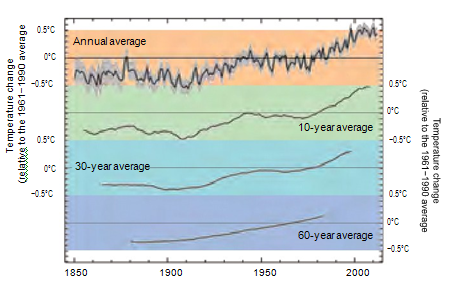
figure 4. As the climate system
varies naturally from year to year
and from decade to decade, reliable
inferences about human-induced
climate change must be made with
a longer view, using multi-decadal
and longer records. Calculating a
‘running average’ over these longer
timescales allows one to more easily
see long-term trends. For the global
average temperature for the period
1850-2012 (using the data from
the UK Met Office Hadley Centre
relative to the 1961-90 average) the
plots show: (top) the average and
range of uncertainty for annually
averaged data; (2nd plot) the
temperature given for any date is
the average for the ten years about
that date; (3rd plot) the equivalent
picture for 30-year; and (4th plot)
the 60-year averages. Source: Met
Office, based on the HadCRUT4 dataset
from the Met Office and Climatic
Research Unit (Morice et al., 2012). | Yes. The observed warming rate has varied from year to year, decade to decade, and place
to place, as is expected from our understanding of the climate system. These shorterterm
variations are mostly due to natural causes, and do not contradict our fundamental
understanding that the long-term warming trend is primarily due to human-induced
changes in the atmospheric levels of CO2 and other greenhouse gases. Even as CO2 is rising steadily in the atmosphere, leading to gradual warming of Earth’s surface, many natural
factors are modulating this long-term warming. Large volcanic eruptions increase the number of small
particles in the stratosphere that reflect sunlight, leading to short-term surface cooling lasting typically two
to three years, followed by a slow recovery. Ocean circulation and mixing vary naturally on many time scales,
causing variations in sea surface temperatures as well as changes in the rate at which heat is transported to
greater depths. For example, the tropical Pacific swings between warm El Niño and cooler La Niña events
on timescales of two to seven years. Scientists know of and study many different types of climate variations,
such as those on decadal and multi-decadal timescales in the Pacific and North Atlantic Oceans, each with
its own unique characteristics. These oceanic variations are associated with significant regional and global
shifts in temperature and rainfall patterns that are evident in the observations.
Warming from decade to decade can also be affected by human factors such as variations in the emissions,
from coal-fired power plants and other pollution sources, of greenhouse gases and of aerosols (airborne
particles that can have both warming and cooling effects).
These variations in the temperature trend are clearly evident in the observed temperature record [Figure
4]. Short-term natural climate variations could also affect the long-term human-induced climate change
signal and vice-versa, because climate variations on different space and timescales can interact with
one another. It is partly for this reason that climate change projections are made using climate models
(see infobox, p.20) that can account for many different types of climate variations and their interactions.
Reliable inferences about human-induced climate change must be made with a longer view, using records
that cover many decades. | | | Source: NAS | URL: http://dels.nas.edu/resources/static-assets/exec-office-other/climate-change-QA.pdf
(The text for the image(s) on this Web page was taken from the above source.) |
Global Sea-level Rise 1960-2013
How confident are scientists that Earth will warm further over the coming century?
| National Academy of Sciences - Climate Change: Evidence and Causes | | How confident are scientists that Earth will warm further over the coming century? | 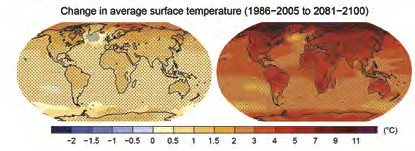
figure 8. If emissions continue
on their present trajectory, without
either technological or regulatory
abatement, then the best estimate
is that global average temperature
will warm a further 2.6 to 4.8 °C
(4.7 to 8.6 °F) by the end of the
century (right). The figure on left
shows projected warming with very
aggressive emissions reductions.
The figures represent multi-model
estimates of temperature averages
for 2081-2100 compared to
1986–2005. Source: IPCC AR5 | Very confident. If emissions continue on their present trajectory, without either technological
or regulatory abatement, then warming of 2.6 to 4.8 °C (4.7 to 8.6 °F) in addition to that
which has already occurred would be expected by the end of the 21st century. Warming due to the addition of large amounts of greenhouse gases to the atmosphere can be understood in
terms of very basic properties of greenhouse gases. It will in turn lead to many changes in natural climate processes,
with a net effect of amplifying the warming. The size of the warming that will be experienced depends
largely on the amount of greenhouse gases accumulating in the atmosphere and hence on the trajectory
of emissions [Figure 8]. If the total cumulative emissions since 1870 are kept below about 1 trillion (million
million) tonnes of carbon, then there is a two-thirds chance of keeping the rise in global average temperature
since the pre-industrial period below 2 °C (3.6 oF). However, over half this amount has already been emitted.
Based just on the established physics of the amount of heat CO2 absorbs and emits, a doubling of
atmospheric CO2 concentration from pre-industrial levels (up to about 560 ppm) would by itself, without
amplification by any other effects, cause a global average temperature increase of about 1 °C (1.8 °F).
However, the total amount of warming from a given amount of emissions depends on chains of effects
(feedbacks) that can individually either amplify or diminish the initial warming.
The most important amplifying feedback is caused by water vapour, which is a potent greenhouse gas in the
atmosphere as warmer air can hold more moisture. Also, as Arctic sea ice and glaciers melt, more sunlight
is absorbed into the darker underlying land and ocean surfaces causing further warming and further melting
of ice and snow. The biggest uncertain factor in our knowledge of feedbacks is in how the properties of
clouds will change in response to climate change. Other feedbacks involve the carbon cycle. Currently the
land and oceans together absorb about half of the CO2 emitted from human activities, but the capacities of
land and ocean to store additional carbon are expected to decrease with additional warming, leading to faster
increases in atmospheric CO2 and faster warming. Models vary in their projections of how much additional
warming to expect, but all such models agree that the overall net effect of feedbacks is to amplify the CO2 —
only warming by a factor of 1.5 to 4.5. | | | Source: NAS | URL: http://dels.nas.edu/resources/static-assets/exec-office-other/climate-change-QA.pdf
(The text for the image(s) on this Web page was taken from the above source.) |
How fast is sea level rising?
| National Academy of Sciences - Climate Change: Evidence and Causes | | How fast is sea level rising? | 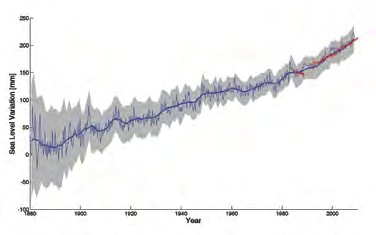
figure 6. Observations show that
the global average sea level has
risen by about 20 cm (8 inches)
since the late 19th century. Sea level
is rising faster in recent decades;
measurements from tide gauges
(blue) and satellites (red) indicate
that the best estimate for the
average sea level rise over the last
two decades is centred on 3.2 mm
per year (0.12 inches per year). The
shaded area represents the sea level
uncertainty, which has decreased as
the number of gauge sites used in
the global averages and the number
of data points have increased.
Source: Shum and Kuo (2011) | Long-term measurements of tide gauges and recent satellite data show that global sea
level is rising, with best estimates of the global-average rise over the last two decades
centred on 3.2 mm per year (0.12 inches per year). The overall observed rise since 1901 is
about 20 cm (8 inches) This sea-level rise has been driven by (in order of importance): expansion of water volume as the ocean
warms, melting of mountain glaciers in most regions of the world, and losses from the Greenland and
Antarctic ice sheets. All of these result from a warming climate. Fluctuations in sea level also occur due to
changes in the amounts of water stored on land. The amount of sea level change experienced at any given
location also depends on a variety of other factors, including whether regional geological processes and
rebound of the land weighted down by previous ice sheets are causing the land itself to rise or sink, and
whether changes in winds and currents are piling ocean water against some coasts or moving water away.
The effects of rising sea level are felt most acutely in the increased frequency and intensity of occasional
storm surges. If CO2 and other greenhouse gases continue to increase on their current trajectories, it is
projected that sea level may rise by a further 0.5 to 1 m (1.5 to 3 feet) by 2100. But rising sea levels will
not stop in 2100; sea levels will be much higher in the following centuries as the sea continues to take up
heat and glaciers continue to retreat. It remains difficult to predict the details of how the Greenland and
Antarctic Ice Sheets will respond to continued warming, but it is thought that Greenland and perhaps West
Antarctica will continue to lose mass, whereas the colder parts of Antarctica could start to gain mass as
they receive more snowfall from warmer air that contains more moisture. Sea level in the last interglacial
(warm) period around 125,000 years ago peaked at probably 5 to 10 m above the present level. During this
period, the polar regions were warmer than they are today. This suggests that, over millennia, long periods
of increased warmth will lead to very significant loss of parts of the Greenland and Antarctic Ice Sheets and
to consequent sea level rise. | | | Source: NAS | URL: http://dels.nas.edu/resources/static-assets/exec-office-other/climate-change-QA.pdf
(The text for the image(s) on this Web page was taken from the above source.) |
If emissions of greenhouse gases were stopped, would the climate return to the conditions of 200 years ago?
| National Academy of Sciences - Climate Change: Evidence and Causes | | If emissions of greenhouse gases were stopped, would the climate return to the conditions of 200 years ago? | 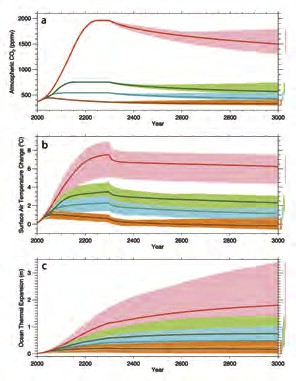
figure 9. If global emissions
were to suddenly stop, it would
take a long time for surface air
temperatures and the ocean to
begin to cool, because the excess
CO2 in the atmosphere would
remain there for a long time and
would continue to exert a warming
effect. Model projections show how
atmospheric CO2 concentration
(a), surface air temperature (b),
and ocean thermal expansion (c)
would respond following a scenario
of business-as-usual emissions
ceasing in 2300 (red), a scenario
of aggressive emission reductions,
falling close to zero 50 years from
now (orange), and two intermediate
emissions scenarios (green and
blue). The small downward tick
in temperature at 2300 is caused
by the elimination of emissions
of short-lived greenhouse gases,
including methane. Source: Zickfeld
et al., 2013 | No. Even if emissions of greenhouse gases were to suddenly stop, Earth’s surface temperature
would not cool and return to the level in the pre-industrial era for thousands of years. If emissions of CO2 stopped altogether, it would take many thousands of years for atmospheric CO2 to
return to ‘pre-industrial’ levels due to its very slow transfer to the deep ocean and ultimate burial in ocean
sediments. Surface temperatures would stay elevated for at least a thousand years, implying extremely
long-term commitment to a warmer planet due to past and current emissions, and sea level would likely
continue to rise for many centuries even after temperature stopped increasing [Figure 9]. Significant
cooling would be required to reverse melting of glaciers and the Greenland ice sheet, which formed
during past cold climates. The current CO2-induced warming of Earth is therefore essentially irreversible
on human timescales. The amount and rate of further warming will depend almost entirely on how much
more CO2 humankind emits. | | | Source: NAS | URL: http://dels.nas.edu/resources/static-assets/exec-office-other/climate-change-QA.pdf
(The text for the image(s) on this Web page was taken from the above source.) |
Is the climate warming?
| National Academy of Sciences - Climate Change: Evidence and Causes | | Is the climate warming? | 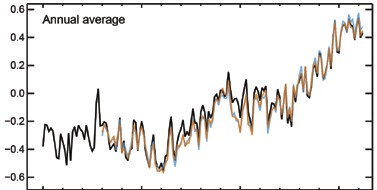
figure1. Earth’s global average
surface temperature has risen as
shown in this plot of combined
land and ocean measurements
from 1850 to 2012, derived from
three independent analyses of the
available data sets. The temperature
changes are relative to the global
average surface temperature of
1961-1990. Source: IPCC AR5, data from
the HadCRUT4 dataset (black), UK Met
Office Hadley Centre, the NCDC MLOST
dataset (orange), US National Oceanic
and Atmospheric Administration, and the
NASA GISS dataset (blue), US National
Aeronautics and Space Administration.
fff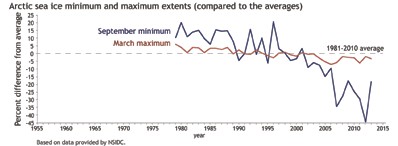
fff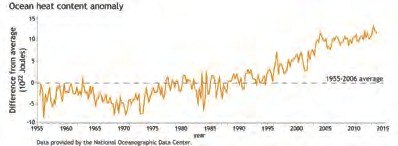
fff
fff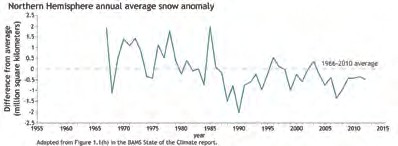
Figure 1b. A large amount of
observational evidence besides
the temperature records shows
that Earth’s climate is changing.
For example, additional evidence
of a warming trend can be found
in the dramatic decrease in the
extent of Arctic sea ice at its
summer minimum (which occurs
in September), decrease in spring
snow cover in the Northern
Hemisphere, increases in the global
average upper ocean (upper 700 m
or 2300 feet) heat content (shown
relative to the 1955–2006 average),
and in sea-level rise.
Source: NOAA climate.gov | Yes. Earth’s average surface air temperature has increased by about 0.8 °C (1.4 °F)
since 1900, with much of this increase taking place since the mid-1970s (figure 1a).
A wide range of other observations (such as reduced Arctic sea ice extent and increased
ocean heat content) and indications from the natural world (such as poleward shifts
of temperature-sensitive species of fish, mammals, insects, etc.) together provide
incontrovertible evidence of planetary-scale warming. The clearest evidence for surface warming comes from widespread thermometer records. In some places,
these records extend back to the late 19th century. Today, temperatures are monitored at many thousands
of locations, over both the land and ocean surface. Indirect estimates of temperature change from such
sources as tree rings and ice cores help to place recent temperature changes in the context of the past. In
terms of the average surface temperature of Earth, these indirect estimates show that 1983 to 2012 was
probably the warmest 30-year period in more than 800 years.
A wide range of other observations provides a more comprehensive picture of warming throughout the
climate system. For example, the lower atmosphere and the upper layers of the ocean have also warmed,
snow and ice cover are decreasing in the Northern Hemisphere, the Greenland ice sheet is shrinking, and
sea level is rising [Figure 1b]. These measurements are made with a variety of monitoring systems, which
gives added confidence in the reality that Earth’s climate is warming. | | | Source: NAS | URL: http://dels.nas.edu/resources/static-assets/exec-office-other/climate-change-QA.pdf
(The text for the image(s) on this Web page was taken from the above source.) |
Is the current level of atmospheric CO2 concentration unprecedented in Earth’s history?
| National Academy of Sciences - Climate Change: Evidence and Causes | | Is the current level of atmospheric CO2 concentration unprecedented in Earth’s history? | 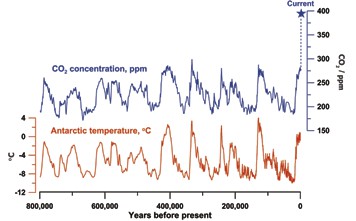
Figure 3. Data from ice cores have
been used to reconstruct Antarctic
temperatures and atmospheric
CO2 concentrations over the past
800,000 years. Temperature is
based on measurements of the
isotopic content of water in the
Dome C ice core. CO2 is measured
in air trapped in ice, and is a
composite of the Dome C and
Vostok ice core. The current CO2
concentration (blue star) is from
atmospheric measurements. The
cyclical pattern of temperature
variations constitutes the ice
age/ interglacial cycles. During
these cycles, changes in CO2
concentrations (in blue) track
closely with changes in temperature
(in red). As the record shows, the
recent increase in atmospheric CO2
concentration is unprecedented
in the past 800,000 years. Source:
Figure by Jeremy Shakun, data from
Lüthi et al., 2008 and Jouzel et al., 2007. | The present level of atmospheric CO2 concentration is almost certainly unprecedented
in the past million years, during which time modern humans evolved and societies
developed. The atmospheric CO2 concentration was however higher in Earth’s more
distant past (many millions of years ago), at which time palaeoclimatic and geological
data indicate that temperatures and sea levels were also higher than they are today. Measurements of air in ice cores show that for the past 800,000 years up until the 20th century, the
atmospheric CO2 concentration stayed within the range 170 to 300 parts per million (ppm), making the recent
rapid rise to nearly 400 ppm over 200 years particularly remarkable [figure 3]. During the glacial cycles of
the past 800,000 years both CO2 and methane have acted as important amplifiers of the climate changes
triggered by variations in Earth’s orbit around the Sun. As Earth warmed from the last ice age, temperature and CO2 started to rise at approximately the same time and continued to rise in tandem from about 18,000 to
11,000 years ago. Changes in ocean temperature, circulation, chemistry and biology caused CO2 to be released
to the atmosphere, which combined with other feedbacks to push Earth into an even warmer state.
For earlier geological times, CO2 concentrations and temperatures have been inferred from less direct
methods. Those suggest that the concentration of CO2 last approached 400 ppm about 3 to 5 million
years ago, a period when global average surface temperature is estimated to have been about 2 to 3.5°C
higher than in the pre-industrial period. At 50 million years ago, CO2 may have reached 1000 ppm, and
global average temperature was probably about 10°C warmer than today. Under those conditions, Earth
had little ice, and sea level was at least 60 metres higher than current levels. | | | Source: NAS | URL: http://dels.nas.edu/resources/static-assets/exec-office-other/climate-change-QA.pdf
(The text for the image(s) on this Web page was taken from the above source.) |
Northern Hemisphere annual average snow anomaly
| National Academy of Sciences - Climate Change: Evidence and Causes | | Northern Hemisphere annual average snow anomaly | 
Figure 1b. A large amount of
observational evidence besides
the temperature records shows
that Earth’s climate is changing.
For example, additional evidence
of a warming trend can be found
in the dramatic decrease in the
extent of Arctic sea ice at its
summer minimum (which occurs
in September), decrease in spring
snow cover in the Northern
Hemisphere, increases in the global
average upper ocean (upper 700 m
or 2300 feet) heat content (shown
relative to the 1955–2006 average),
and in sea-level rise.
Source: NOAA climate.gov | | | Source: NAS | URL: http://dels.nas.edu/resources/static-assets/exec-office-other/climate-change-QA.pdf
(The text for the image(s) on this Web page was taken from the above source.) |
Ocean Heat Content Anomaly
What is ocean acidification and why does it matter?
| National Academy of Sciences - Climate Change: Evidence and Causes | | What is ocean acidification and why does it matter? | 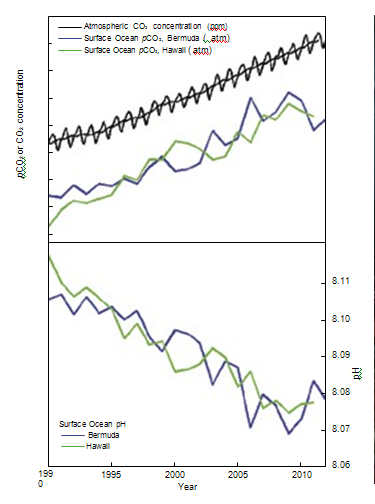
figure 7. As CO2 in the air has
increased, there has been an
increase in the CO2 content of the
surface ocean (upper box), and a
decrease in the seawater pH (lower
box). Source: adapted from Dore et al.
(2009) and Bates et al. (2012). | Direct observations of ocean chemistry have shown that the chemical balance of seawater
has shifted to a more acidic state (lower pH) [Figure 7]. Some marine organisms (such
as corals and some shellfish) have shells composed of calcium carbonate which dissolves
more readily in acid. As the acidity of sea water increases, it becomes more difficult for
them to form or maintain their shells. CO2 dissolves in water to form a weak acid, and the oceans have absorbed about a third of the CO2 resulting
from human activities, leading to a steady decrease in ocean pH levels. With increasing atmospheric CO2,
the chemical balance will change even more during the next century. Laboratory and other experiments
show that under high CO2 and in more acidic waters, some marine species have misshapen shells and
lower growth rates, although the effect varies among species. Acidification also alters the cycling of
nutrients and many other elements and compounds in the ocean, and it is likely to shift the competitive
advantage among species, with as-yet-to-be-determined impacts on marine ecosystems and the food web. | | | Source: NAS | URL: http://dels.nas.edu/resources/static-assets/exec-office-other/climate-change-QA.pdf
(The text for the image(s) on this Web page was taken from the above source.) |
What role has the Sun played in climate change in recent decades?
| National Academy of Sciences - Climate Change: Evidence and Causes | | What role has the Sun played in climate change in recent decades? | 
figure 2. Measurements of the
Sun’s energy incident on Earth
show no net increase in solar
forcing during the past 30 years,
and therefore this cannot be
responsible for warming during
that period. The data show only
small periodic amplitude variations
associated with the Sun’s 11-year
cycle. Figure by Keith Shine.
Source: TSI data from Physikalisch-
Meteorologisches Observatorium
Davos, Switzerland, adjusted down
by 4.46 W m-2 to agree with the 2008
solar minimum data from Kopp and
Lean, 2011; temperature data from the
HadCRUT4 dataset, UK | The Sun provides the primary source of energy driving Earth’s climate system, but its
variations have played very little role in the climate changes observed in recent decades.
Direct satellite measurements since the late 1970s show no net increase in the Sun’s output,
while at the same time global surface temperatures have increased For earlier periods, solar changes are less certain because they are inferred from indirect
sources — including the number of sunspots and the abundance of certain forms (isotopes) of carbon
or beryllium atoms, whose production rates in Earth’s atmosphere are influenced by variations in the
Sun. There is evidence that the 11 year solar cycle, during which the Sun’s energy output varies by roughly
0.1%, can influence ozone concentrations, temperatures, and winds in the stratosphere (the layer in the
atmosphere above the troposphere, typically from 12 to 50 km, depending on latitude and season). These
stratospheric changes may have a small effect on surface climate over the 11 year cycle. However, the
available evidence does not indicate pronounced long-term changes in the Sun’s output over the past
century, during which time human-induced increases in CO2 concentrations have been the dominant
influence on the long-term global surface temperature increase. Further evidence that current warming
is not a result of solar changes can be found in the temperature trends at different altitudes in the
atmosphere (see Question 5). | | | Source: NAS | URL: http://dels.nas.edu/resources/static-assets/exec-office-other/climate-change-QA.pdf
(The text for the image(s) on this Web page was taken from the above source.) |
Why is Arctic sea ice decreasing while Antarctic sea ice is not?
| National Academy of Sciences - Climate Change: Evidence and Causes | | Why is Arctic sea ice decreasing while Antarctic sea ice is not? | 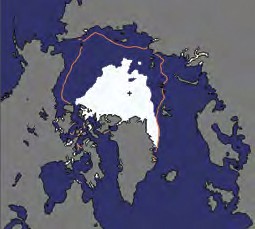
Figure 5. The Arctic summer
sea ice extent in 2012, (measured
in September) was a record low,
shown (in white) compared to the
median summer sea ice extent for
1979 to 2000 (in orange outline). In
2013, Arctic summer sea ice extent
rebounded somewhat, but was still
the sixth smallest extent on record.
Source: National Snow and Ice Data
Center | Sea ice extent is affected by winds and ocean currents as well as temperature. Sea ice
in the partly-enclosed Arctic Ocean seems to be responding directly to warming, while
changes in winds and in the ocean seem to be dominating the patterns of climate and sea
ice change in the ocean around Antarctica. Sea ice in the Arctic has decreased dramatically since the late 1970s, particularly in summer and autumn.
Since the satellite record began in 1978 (providing for the first time a complete and continuous areal
coverage of the Arctic), the yearly minimum Arctic sea ice extent (which occurs in early to mid-September)
has decreased by more than 40% [Figure 5]. Ice cover expands again each Arctic winter but the ice is
thinner than it used to be. Estimates of past sea ice extent suggest that this decline may be unprecedented
in at least the past 1,450 years. The total volume of ice, the product of ice thickness and area, has
decreased faster than ice extent over the past decades. Because sea ice is highly reflective, warming is
amplified as the ice decreases and more sunshine is absorbed by the darker underlying ocean surface.
Sea ice in the Antarctic has shown a slight increase in extent since 1979 overall, although some areas,
such as that to the west of the Antarctic Peninsula, have experienced a decrease. Changes in surface
wind patterns around the continent have contributed to the Antarctic pattern of sea ice change while
ocean factors such as the addition of cool fresh water from melting ice shelves may also have played a
role. The wind changes include a recent strengthening of westerly winds, which reduces the amount of
warm air from low latitudes penetrating into the southern high latitudes and alters the way in which ice
moves away from the continent. The change in winds may result in part from the effects of stratospheric
ozone depletion over Antarctica (i.e., the ozone hole, a phenomenon that is distinct from the humandriven
changes in long-lived
greenhouse gases discussed in
this document). However, shortterm
trends in the Southern
Ocean, such as those observed,
can readily occur from natural
variability of the atmosphere,
ocean and sea ice system. | | | Source: NAS | URL: http://dels.nas.edu/resources/static-assets/exec-office-other/climate-change-QA.pdf
(The text for the image(s) on this Web page was taken from the above source.) |
|
|